A Wide-Range Negative Output DC-DC Converter with Adaptive Drive Technique for Active-Matrix OLED Microdisplays
Abstract
:1. Introduction
2. Control System Design for the Proposed Buck–Boost Converter
2.1. Control System Composition
2.2. Control System Operation Principle
3. Stability Analysis and Circuit Implementation
3.1. Loop Stability Analysis
3.2. Implementation of Voltage Control Loop
3.3. Implementation of Current Control Loop
3.4. Clock Oscillator and Slope Compensation Circuit
3.5. Implementation of PWM Comparator
3.6. Implementation of the Drive Circuit
3.6.1. Dead-Time Control Circuit
3.6.2. Bootstrap Circuit
3.6.3. Clamp and Level-Down Circuit
4. Post-Layout Simulation Results
5. Conclusions
- This paper addresses the design of a Buck–Boost converter for high-resolution microdisplay driver circuits, featuring a wide output voltage range, low output voltage ripple, and robust load-bearing capacity. Employing a dual-loop control mode for voltage and current, the converter combines peak current sampling control technology with pulse width modulation control mode. The proposed peak current sampling circuit, which integrates overcurrent protection functionality, achieves high-precision sampling of the power switch transistor, effectively reducing output voltage ripple and improving line regulation.
- The adaptive driving scheme proposed based on the CMOS process effectively addresses the issue of driving power switches in a synchronous rectification Buck–Boost structure, particularly within a wide output voltage range. The proposed level-down circuit utilizes a two-stage positive feedback latch structure to efficiently accelerate the flipping speed of the output level, enhancing the driving capability.
- Post-layout simulation results indicate that the proposed Buck–Boost converter in this paper can deliver stable and low-ripple output voltage across the entire operating range. It demonstrates adaptability to various scenarios, making it versatile and providing a new solution for the power management aspect of AMOLED microdisplay driver systems.
- For convenience in understanding this paper, Abbreviations summarizes the abbreviations and other symbols mentioned, along with their corresponding explanations.
Author Contributions
Funding
Data Availability Statement
Conflicts of Interest
Abbreviations
| AMOLED | active-matrix organic light-emitting diode |
| OLED | organic light-emitting diode |
| DLC | dual-loop control |
| PCST | peak-current-sensing technique |
| ADT | adaptive drive technique |
| CCM | continuous conduction mode |
| PWM | pulse width modulation |
| input voltage source | |
| inductor | |
| capacitor | |
| sampling transistor | |
| main switch transistors | |
| synchronous rectification transistor | |
| current sensing circuit | |
| OSC | oscillator |
| OCP | overcurrent protection circuit |
| slope compensation rate | |
| inductor current decay rate | |
| operating period | |
| PI controller | Proportional–Integral controller |
| PVT | Process, Voltage, and Temperature |
| LNR | linear regulation |
| LDR | load regulation |
References
- Dai, Y. Technology for LCOS Micro-display. Chin. J. Liq. Cryst. Disp. 2009, 24, 471–477. [Google Scholar]
- Hiroki, O.; Toshinari, S.; Kousei, N. QVGA AMOLED Display Using In-Ga-Zn-Oxide TFTs with a Novel Passivation Layer; Blackwell Publishing Ltd.: Oxford, UK, 2009. [Google Scholar]
- Chen, Y.; Geng, D.; Jang, J. Integrated Active-Matrix Capacitive Sensor using a-IGZO TFTs for AMOLED. IEEE J. Electron Devices Soc. 2018, 6, 214–218. [Google Scholar] [CrossRef]
- Wu, C.H.; Chen, C.L. Multi-Phase Charge Pump Generating Positive and Negative High Voltages for TFT-LCD Gate Driving. In Proceedings of the 4th IEEE International Symposium on Electronic Design, Test and Applications (Delta 2008), Hong Kong, China, 23–25 January 2008; pp. 179–183. [Google Scholar]
- Mao, F.; Lu, Y.; Bonizzoni, E.; Boera, F.; Huang, M.; Maloberti, F.; Martins, R.P. A Hybrid Single-Inductor Bipolar-Output DC–DC Converter With Floating Negative Output for AMOLED Displays. IEEE J. Solid-State Circuits 2021, 56, 2760–2769. [Google Scholar] [CrossRef]
- Hong, S.W. A 1.46 mm2 Simultaneous Energy-Transferring Single-Inductor Bipolar-Output Converter with a Flying Capacitor for Highly Efficient AMOLED Display in 0.5 µm CMOS. In Proceedings of the 2020 IEEE International Solid-State Circuits Conference (ISSCC), San Francisco, CA, USA, 16–20 February 2020; pp. 200–202. [Google Scholar]
- Kadlimatti, V.; Thota, P.; Bhat, S. A Novel Methodology of PWM/PFM Mode Transition for Inverting Buck-Boost and Boost Converter for AMOLED Display Applications. In Proceedings of the 2020 33rd International Conference on VLSI Design and 2020 19th International Conference on Embedded Systems (VLSID), Bangalore, India, 4–8 January 2020; pp. 165–170. [Google Scholar]
- Gegner, J.P.; Lee, C.Q. Linear peak current mode control: A simple active power factor correction control technique for continuous conduction mode. PESC Record. In Proceedings of the 27th Annual IEEE Power Electronics Specialists Conference, Baveno, Italy, 23–27 June 1996; pp. 196–202. [Google Scholar]
- Banba, H.; Shiga, H.; Umezawa, A. A CMOS bandgap reference circuit with sub-1-V operation. IEEE J. Solid-State Circuits 1999, 34, 670–674. [Google Scholar] [CrossRef]
- Mammano, B.R. Switching power supply topology: Voltage mode vs. current mode. Unitrode Des. Note 1994, 18, 25–27. [Google Scholar]
- Ridley, R.B. A new, continuous-time model for current-mode control (power converters). IEEE Trans. Power Electron. 1991, 6, 271–280. [Google Scholar] [CrossRef]
- Ridley, R.B. A More Accurate Current-Mode Control Model; Ridley Engineering Inc.: Bradenton, FL, USA, 2013. [Google Scholar]
- Tian, F.; Kasemsan, S.; Batarseh, I. An Adaptive Slope Compensation for the Single-Stage Inverter with Peak Current-Mode Control. IEEE Trans. Power Electron. 2011, 26, 2857–2862. [Google Scholar] [CrossRef]
- Forghani-Zadeh, H.P.; Rincon-Mora, G.A. Current-sensing techniques for DC-DC converters. In Proceedings of the 2002 45th Midwest Symposium on Circuits and Systems, MWSCAS-2002, Tulsa, OK, USA, 4–7 August 2002; p. 2. [Google Scholar]
- Hower, P.L. Safe operating area—A new frontier in Ldmos design. In Proceedings of the 14th International Symposium on Power Semiconductor Devices and ICS, Sante Fe, NM, USA, 4–7 January 2002; pp. 1–8. [Google Scholar]
- Guo-Hua, Z.; Jian-Ping, X.; Bo-Cheng, B. Symmetrical dynamics of peak current-mode and valley current-mode controlled switching dc–dc converters with ramp compensation. Chin. Phys. B 2010, 6, 8. [Google Scholar] [CrossRef]
- Changming, P.; Wei, Y.; Ke, Z. DCM, FSM, dead time and width controllers for a high frequency high efficiency buck DC-DC converter over a wide load range. J. Semicond. 2010, 8, 7. [Google Scholar] [CrossRef]
- Chae, C.S.; Le, H.P.; Lee, K.C. A Single-Inductor Step-Up DC-DC Switching Converter with Bipolar Outputs for Active Matrix OLED Mobile Display Panels. IEEE J. Solid State Circuits 2009, 44, 509–524. [Google Scholar] [CrossRef]
- Liu, Z.; Cong, L.; Lee, H. Design of On-Chip Gate Drivers with Power-Efficient High-Speed Level Shifting and Dynamic Timing Control for High-Voltage Synchronous Switching Power Converters. IEEE J. Solid State Circuits 2015, 50, 1463–1477. [Google Scholar] [CrossRef]
- Hong, S.W.; Park, S.H.; Kong, T.H.; Cho, G.H. Inverting Buck-Boost DC-DC Converter for Mobile AMOLED Display Using Real-Time Self-Tuned Minimum Power-Loss Tracking (MPLT) Scheme with Lossless Soft-Switching for Discontinuous Conduction Mode. IEEE J. Solid State Circuit 2015, 50, 2380–2393. [Google Scholar] [CrossRef]
- TPS65632 Datasheet; Texas Instruments: Dallas, TX, USA, 2016.
- Fusetto, S.; Moisello, E.; Petersen, H.; Abedinpour, S.; Malcovati, P.; Bonizzoni, E. An 87.2%-peak efficiency 4.1 W-output power switched capacitor 3-level inverting buck-boost dc-dc converter. In Proceedings of the 2023 IEEE Custom Integrated Circuits Conference (CICC), San Antonio, TX, USA, 23–26 April 2023; pp. 1–2. [Google Scholar]
- LMR70503 Datasheet; Texas Instruments: Dallas, TX, USA, 2013.

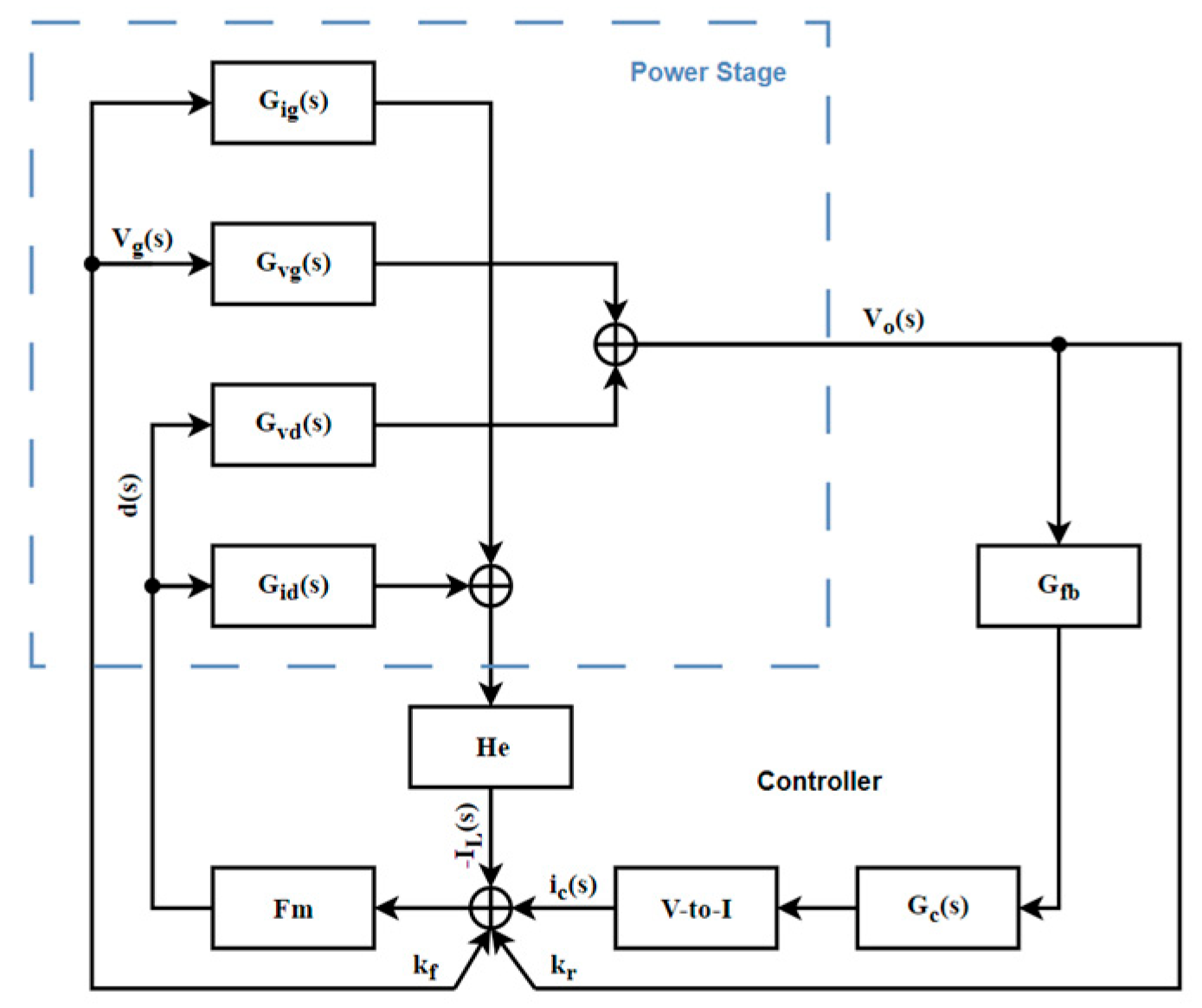
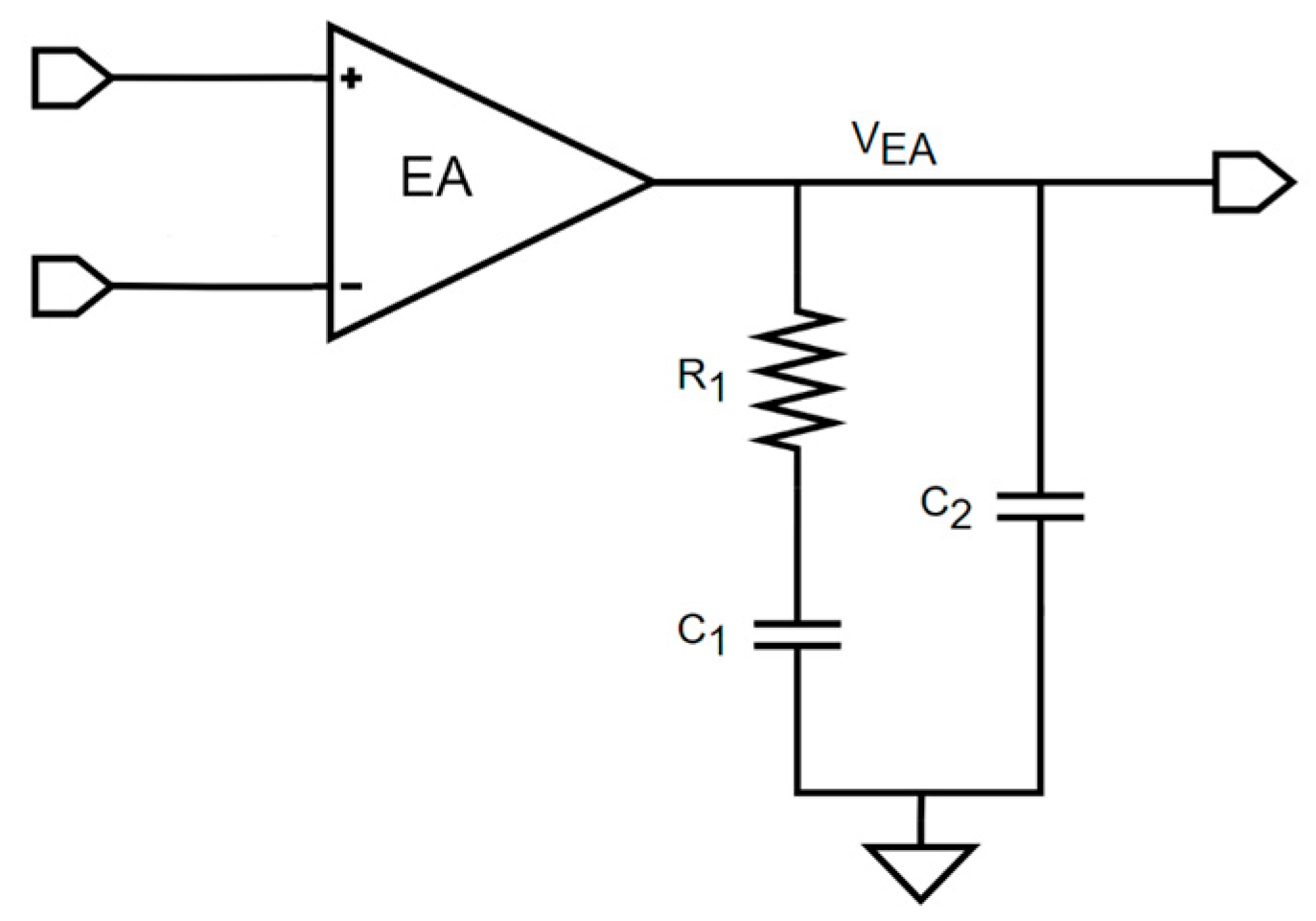

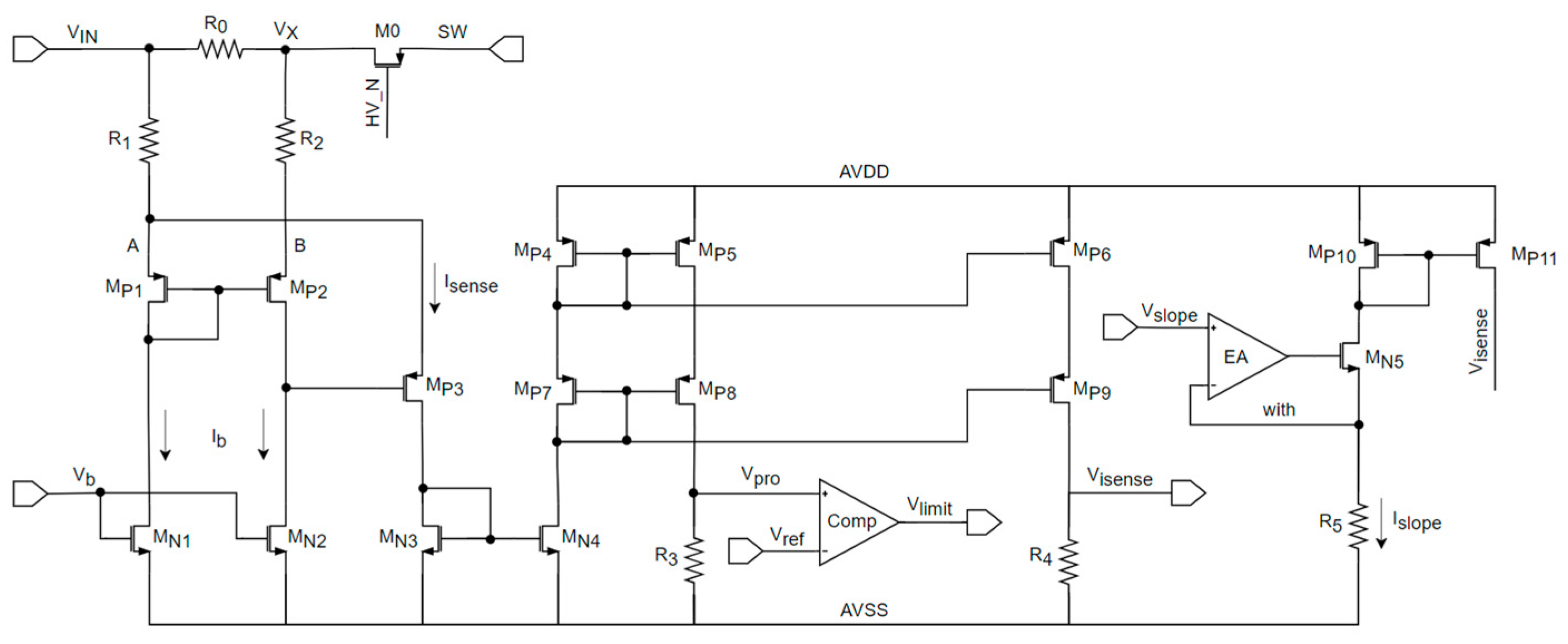

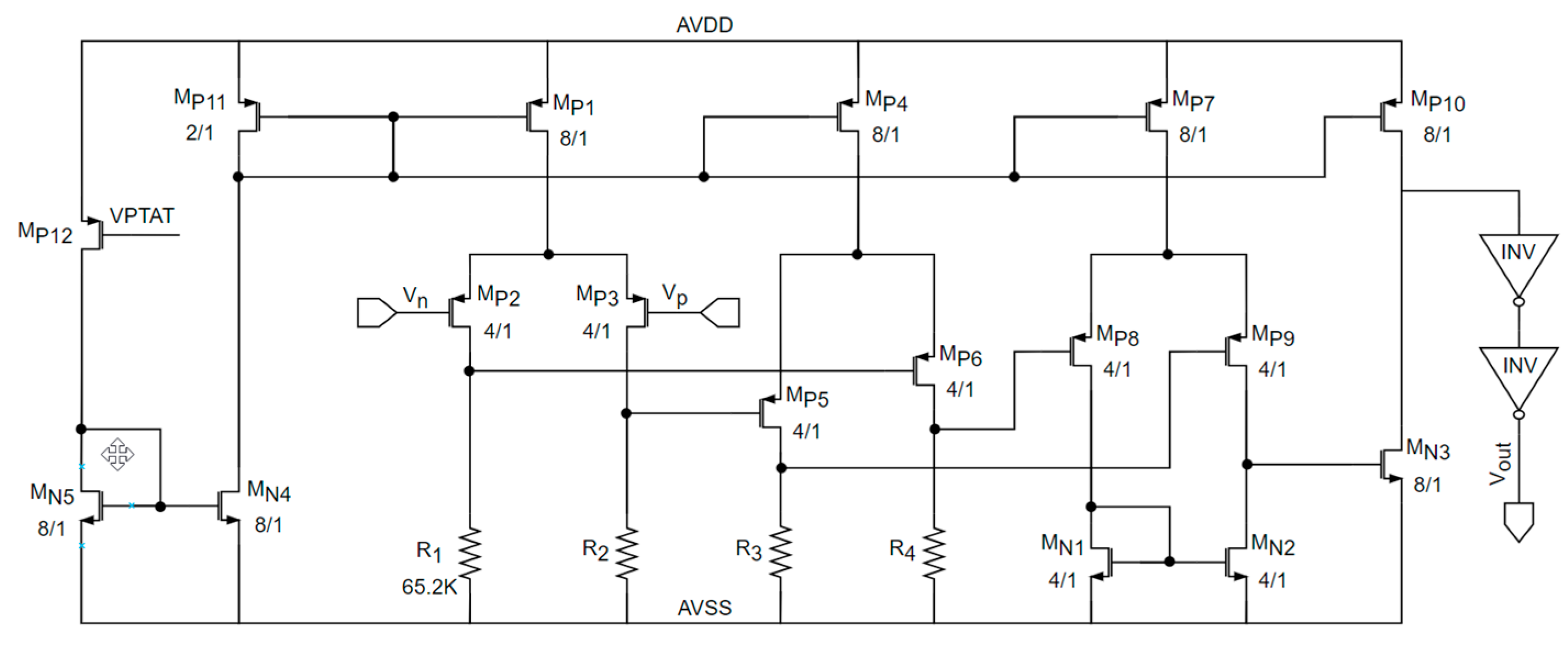



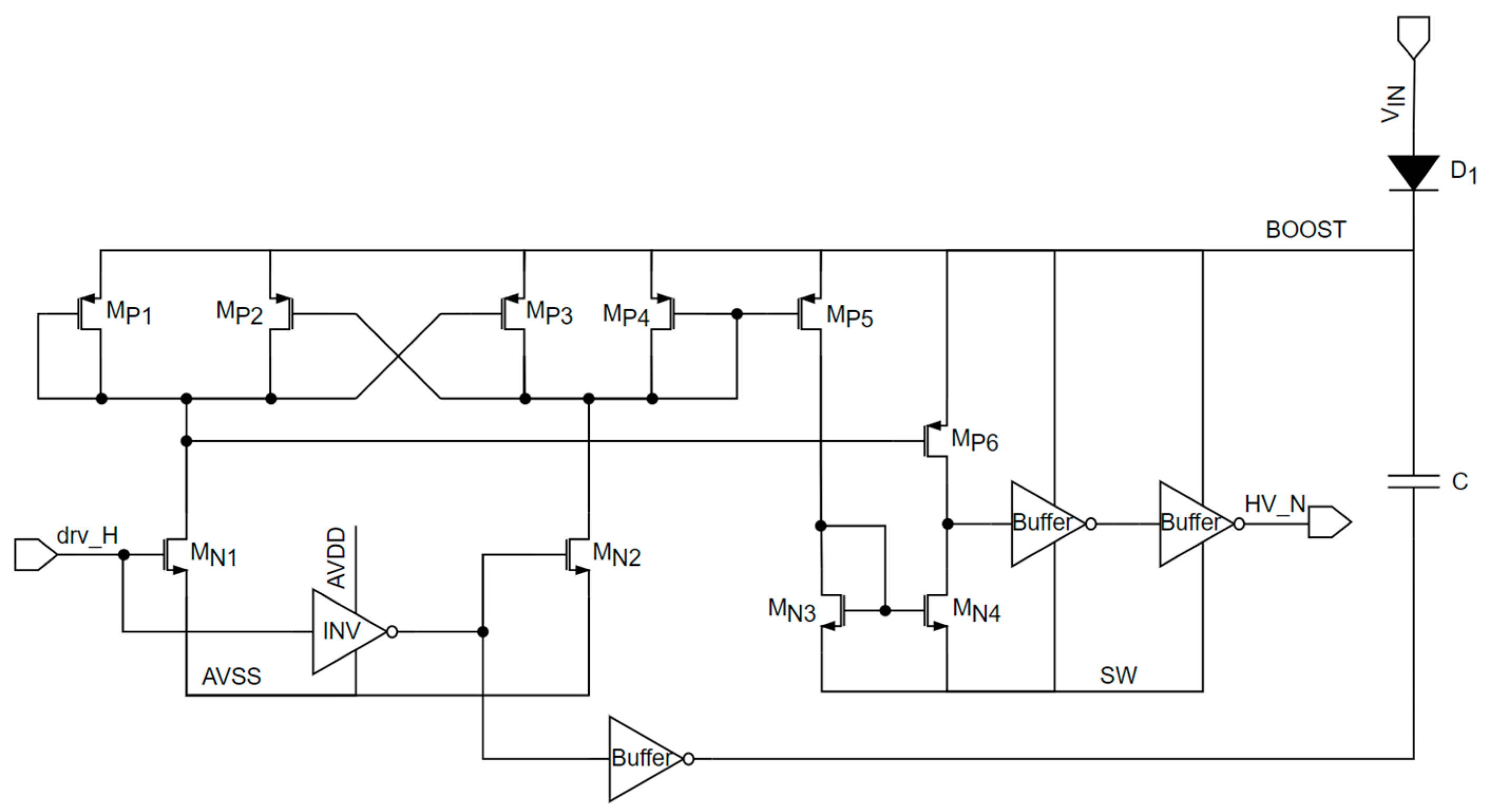
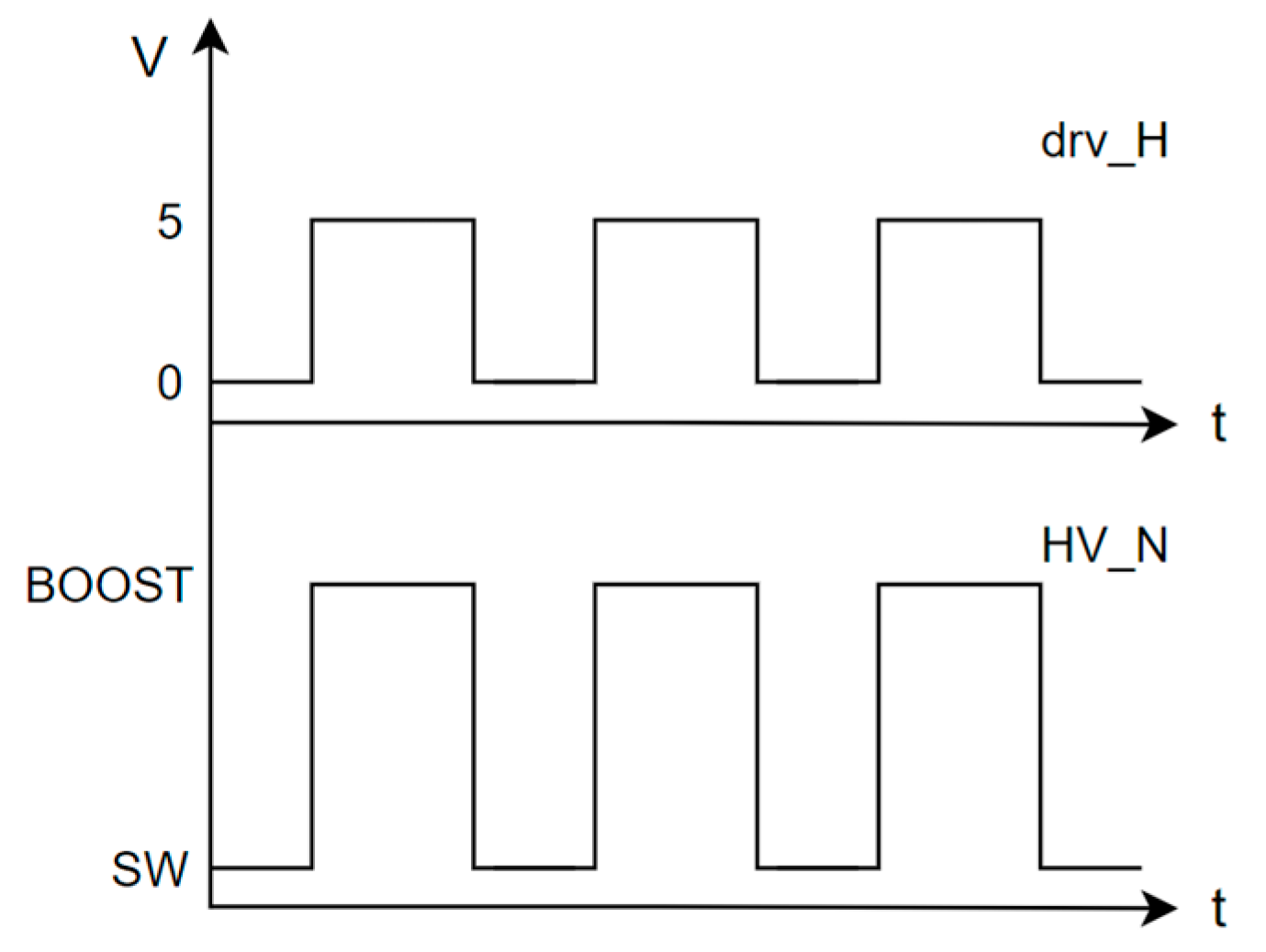
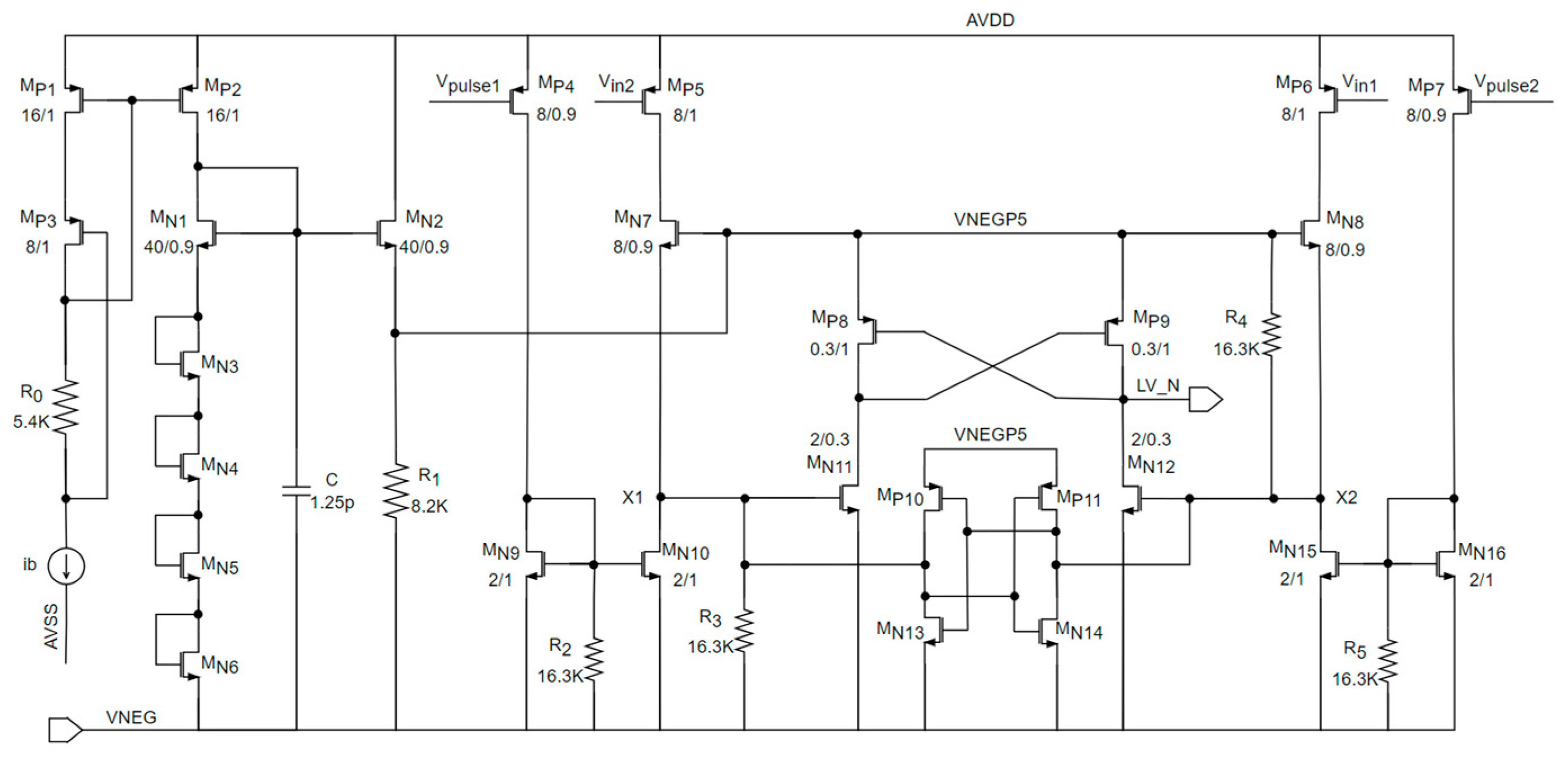

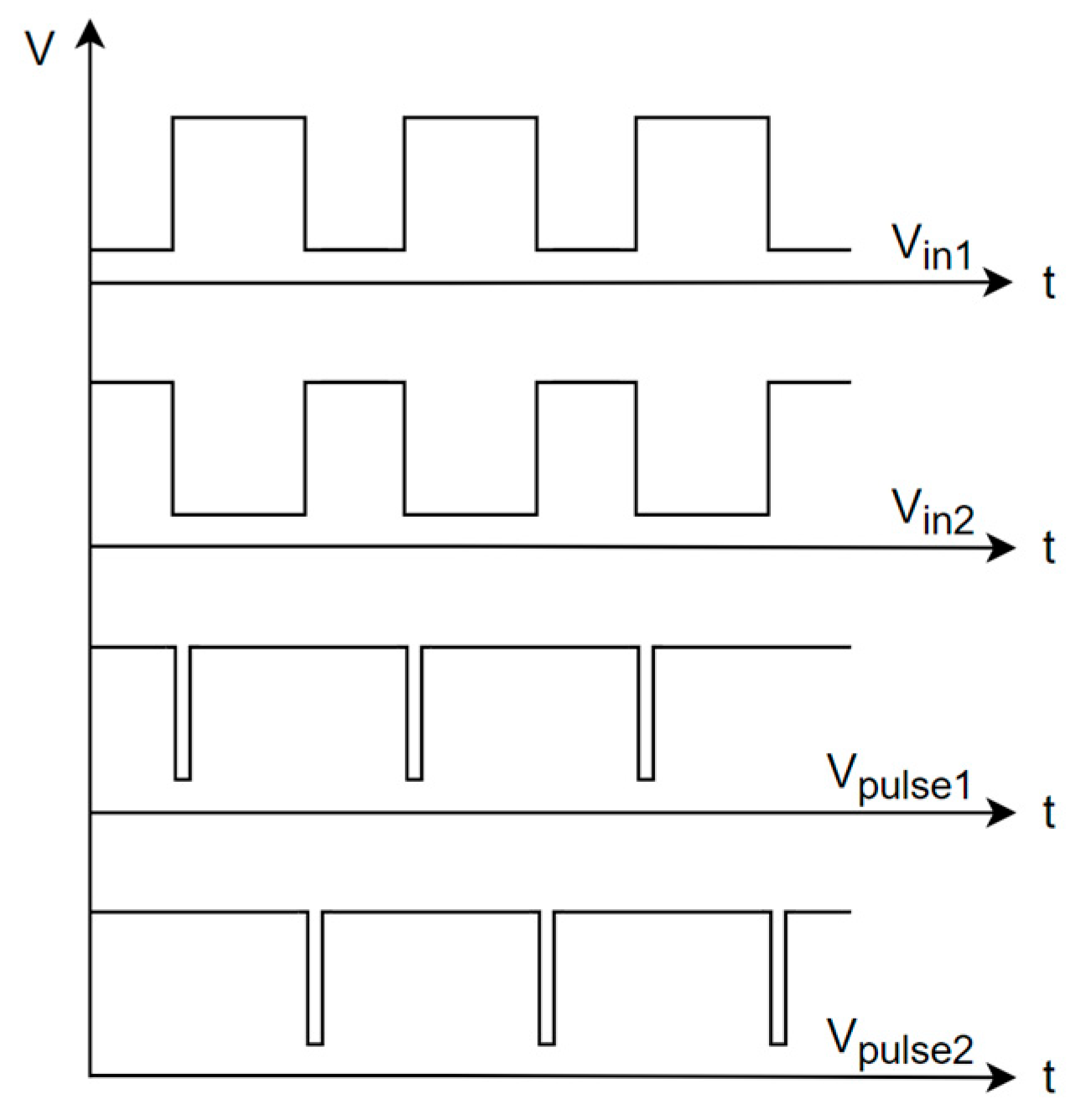
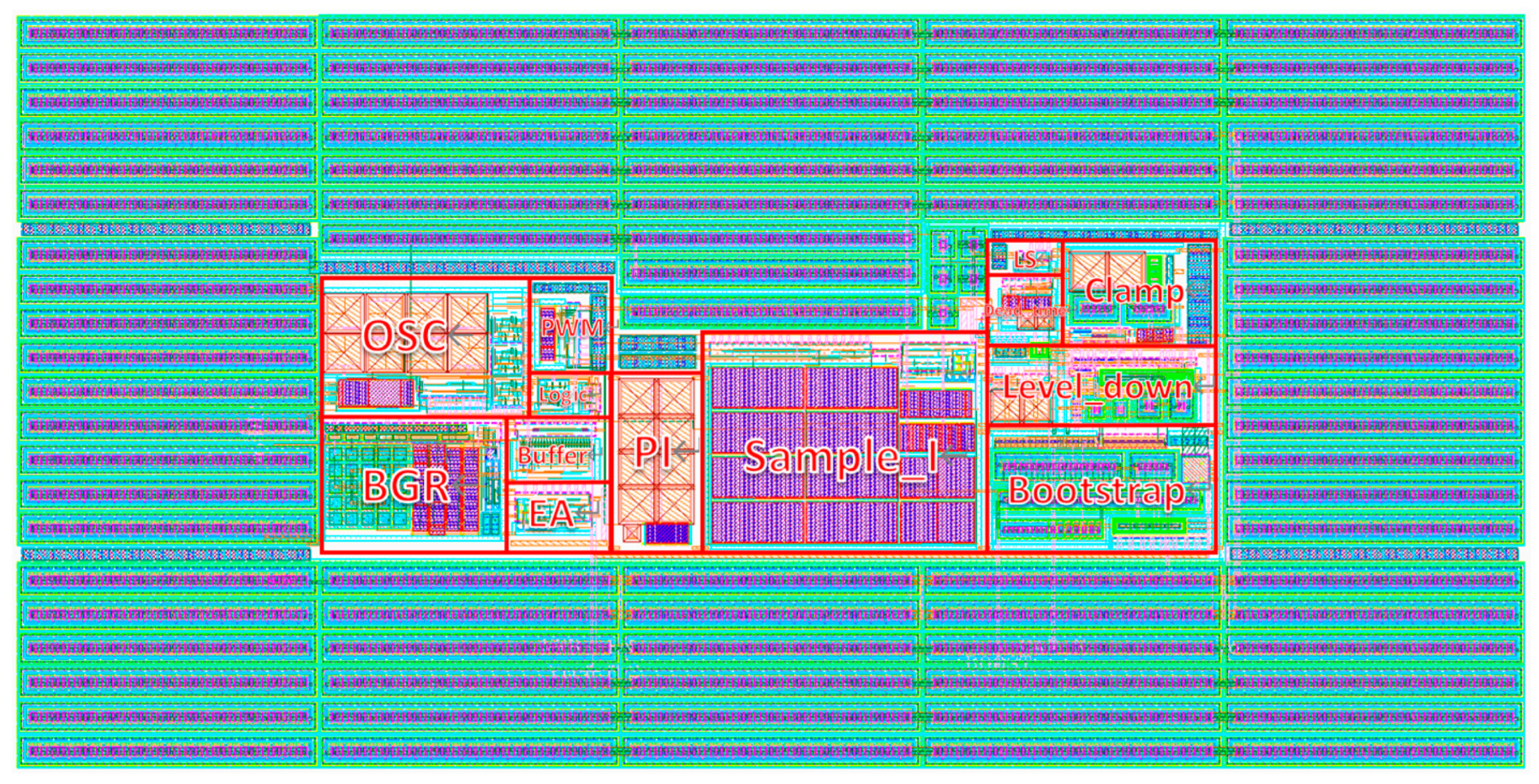


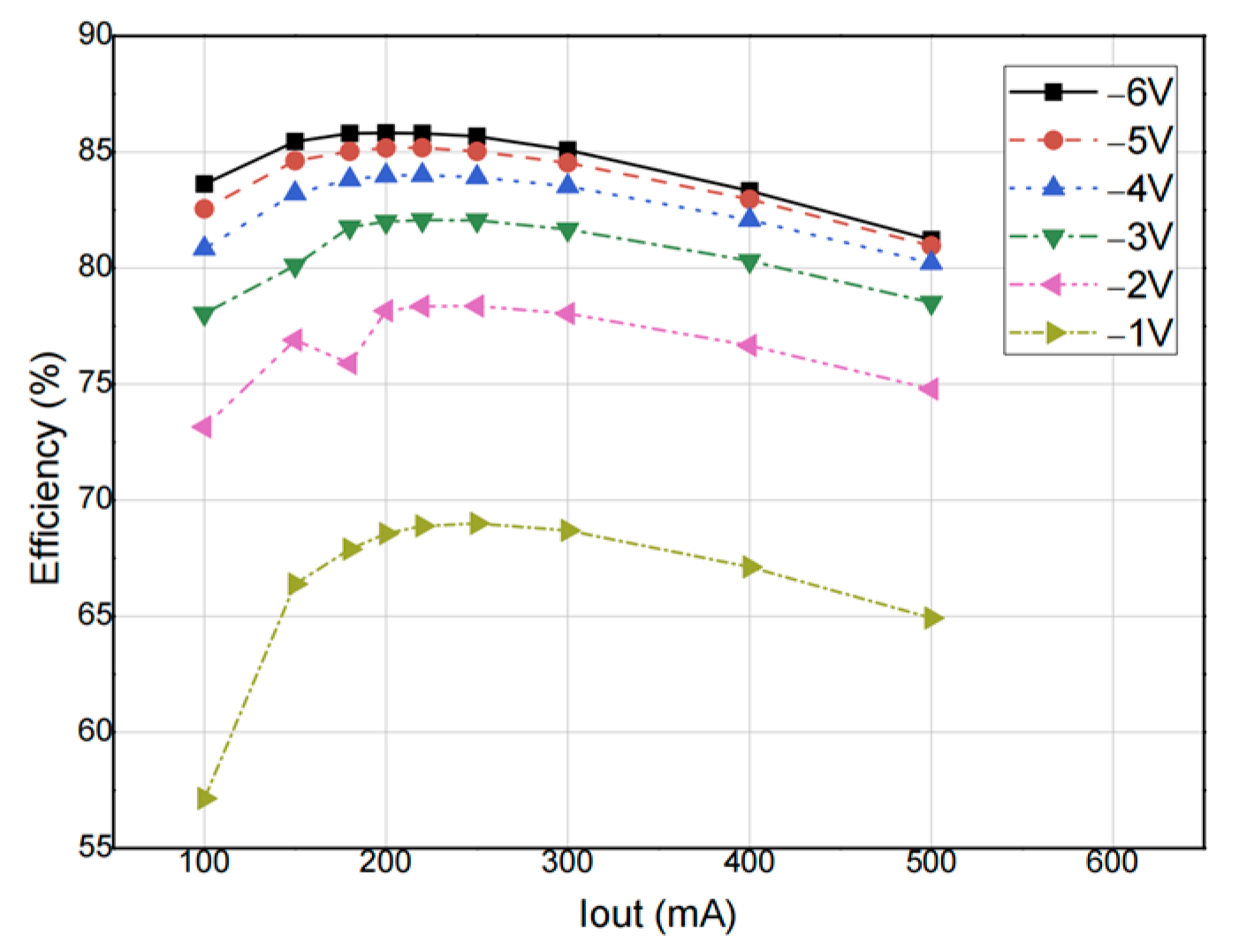
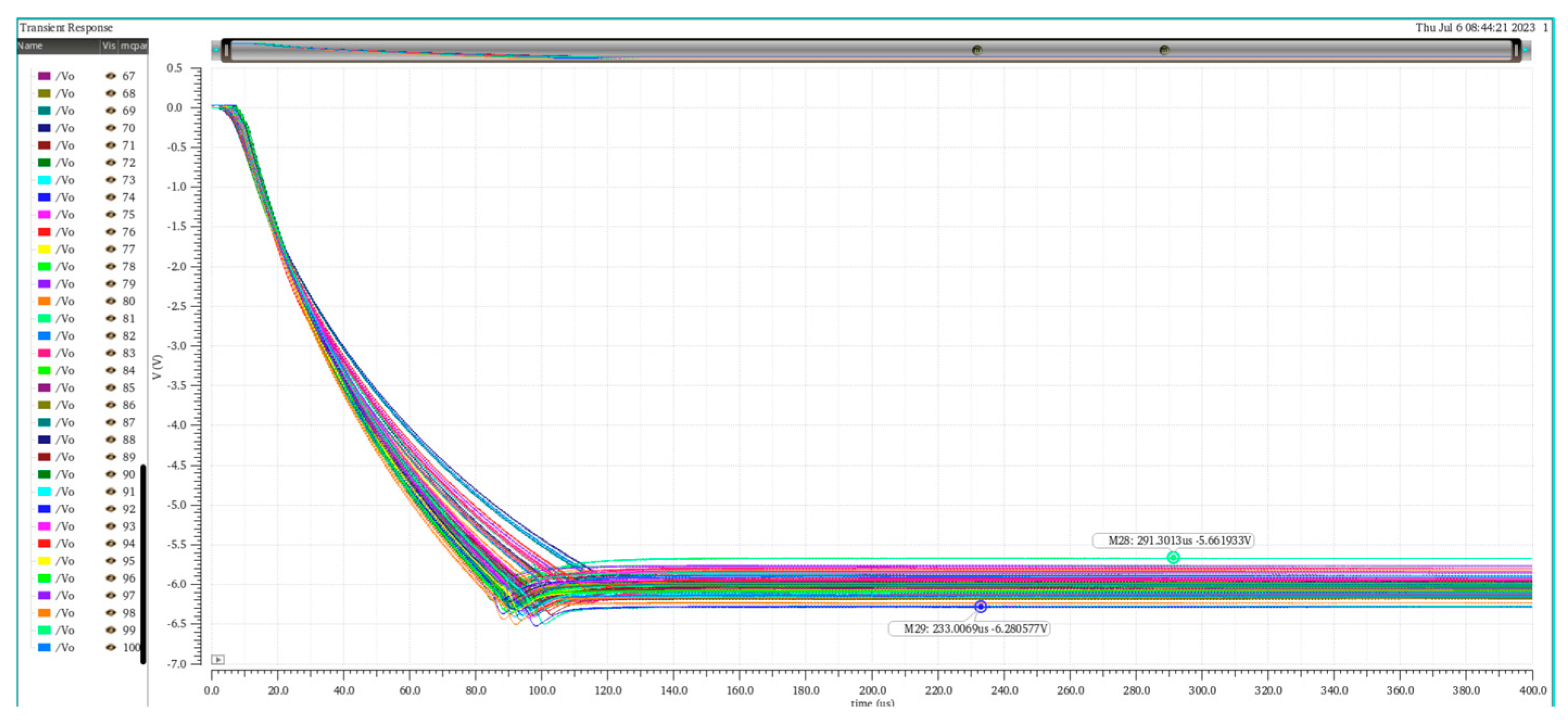


| 100 mA | 200 mA | 300 mA | 400 mA | 500 mA | |
|---|---|---|---|---|---|
| −1 V | 0.90 | 1.45 | 2.34 | 3.23 | 4.05 |
| −2 V | 1.07 | 1.99 | 3.23 | 4.37 | 5.66 |
| −3 V | 1.38 | 2.75 | 4.37 | 5.89 | 7.30 |
| −4 V | 1.50 | 3.05 | 4.75 | 6.80 | 8.27 |
| −5 V | 3.43 | 6.09 | 9.49 | 12.86 | 15.98 |
| −6 V | 3.43 | 6.49 | 10.09 | 13.92 | 17.09 |
| 100 mA → 200 mA | 200 mA → 300 mA | 300 mA → 400 mA | 400 mA → 500 mA | |
|---|---|---|---|---|
| −1 V | 8.21 | 10.56 | 12.89 | 11.76 |
| −2 V | 8.01 | 8.85 | 11.19 | 13.90 |
| −3 V | 8.99 | 11.21 | 14.27 | 13.74 |
| −4 V | 11.66 | 13.67 | 15.49 | 17.16 |
| −5 V | 17.21 | 22.49 | 21.73 | 24.58 |
| −6 V | 23.63 | 23.02 | 26.52 | 29.17 |
| [20] | [21] | [22] | [23] | This Work | |
|---|---|---|---|---|---|
| Process | BCD | — | BCD | — | CMOS |
| Scheme | MPLT | Constant off-time | PWM + Voltage Mode | PFM + Peak-Current Mode | PWM + Peak-Current Mode |
| Input Voltage (V) | 3.7 | 3 | 4 | 3.3 | 5 |
| Inductor | 10 | 4.7 | 1 | 6.8 | 4.7 |
| ) | 4.7 | 20 | 10 | 44 | 20 |
| Switching Frequency (MHz) | 1 | 1.7 | 1 | >0.5 | 2 |
| Maximum Efficiency (%) | 90.5 | >90 | 87.5 | 75 | 85.82 |
| Typical Output Voltage (V) | −4.9 | −4 | −7.5 | −5 | −4 |
| Output Ripple (mV) | 25@140 mA | 12@100 mA | 44@250 mA | 11@70 mA | 1.5@100 mA |
| Load Regulation (mV/mA) | 0.74 | 1.6 | 0.5 | 0.58 | 0.08 |
Disclaimer/Publisher’s Note: The statements, opinions and data contained in all publications are solely those of the individual author(s) and contributor(s) and not of MDPI and/or the editor(s). MDPI and/or the editor(s) disclaim responsibility for any injury to people or property resulting from any ideas, methods, instructions or products referred to in the content. |
© 2024 by the authors. Licensee MDPI, Basel, Switzerland. This article is an open access article distributed under the terms and conditions of the Creative Commons Attribution (CC BY) license (https://creativecommons.org/licenses/by/4.0/).
Share and Cite
Liu, Y.; Cai, H.; Zhao, B. A Wide-Range Negative Output DC-DC Converter with Adaptive Drive Technique for Active-Matrix OLED Microdisplays. Electronics 2024, 13, 564. https://doi.org/10.3390/electronics13030564
Liu Y, Cai H, Zhao B. A Wide-Range Negative Output DC-DC Converter with Adaptive Drive Technique for Active-Matrix OLED Microdisplays. Electronics. 2024; 13(3):564. https://doi.org/10.3390/electronics13030564
Chicago/Turabian StyleLiu, Yue, Hong Cai, and Bohua Zhao. 2024. "A Wide-Range Negative Output DC-DC Converter with Adaptive Drive Technique for Active-Matrix OLED Microdisplays" Electronics 13, no. 3: 564. https://doi.org/10.3390/electronics13030564





